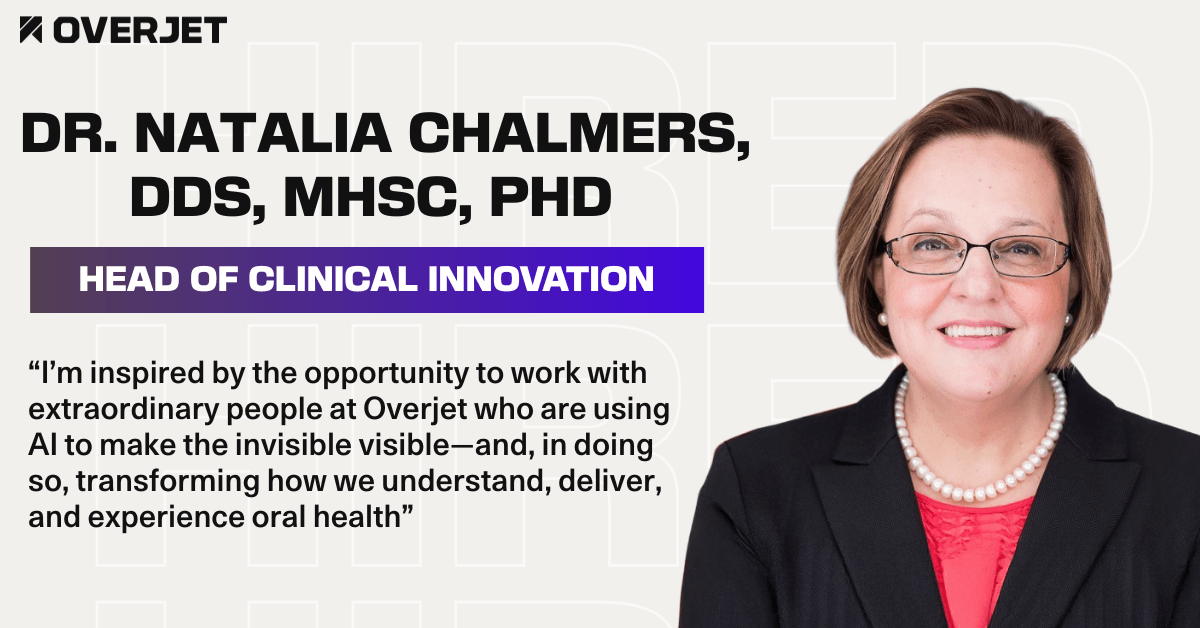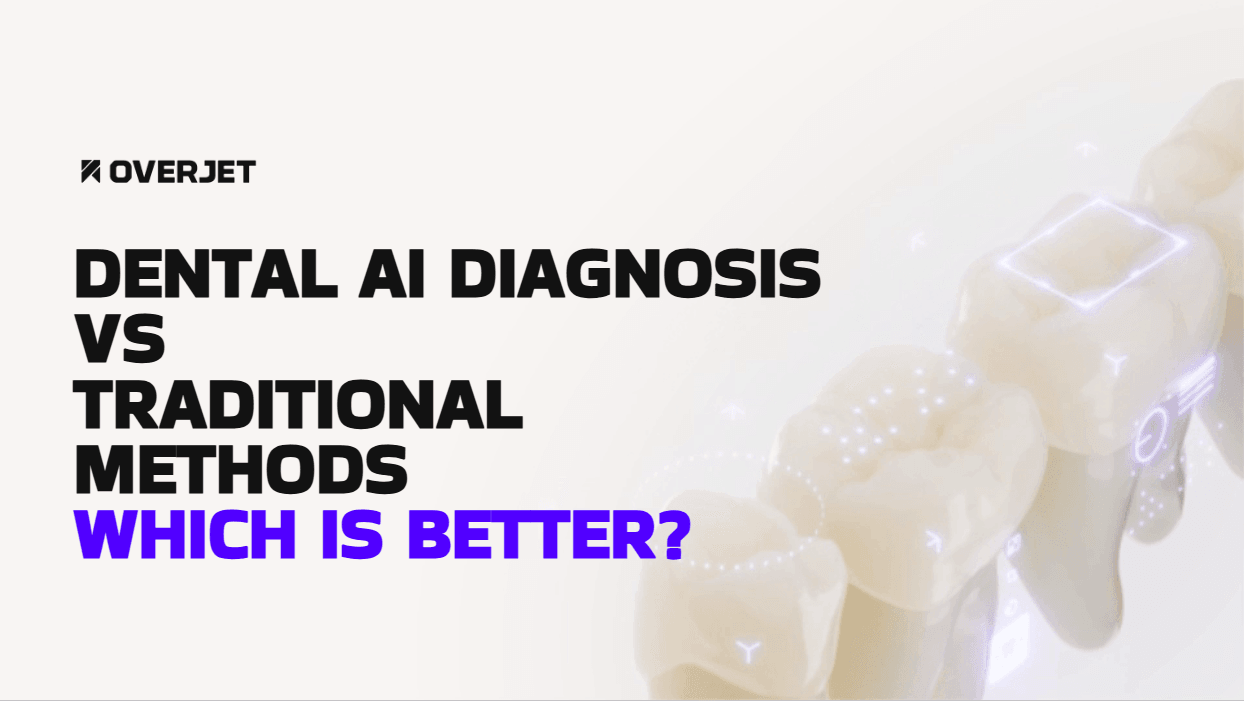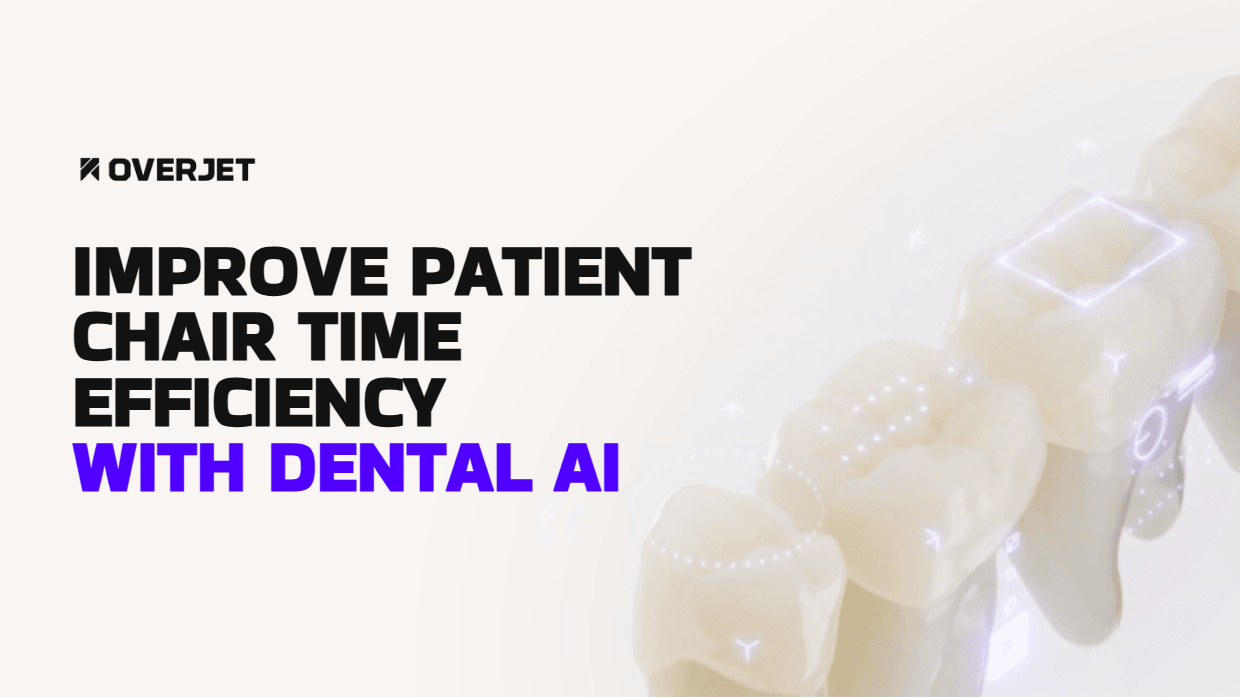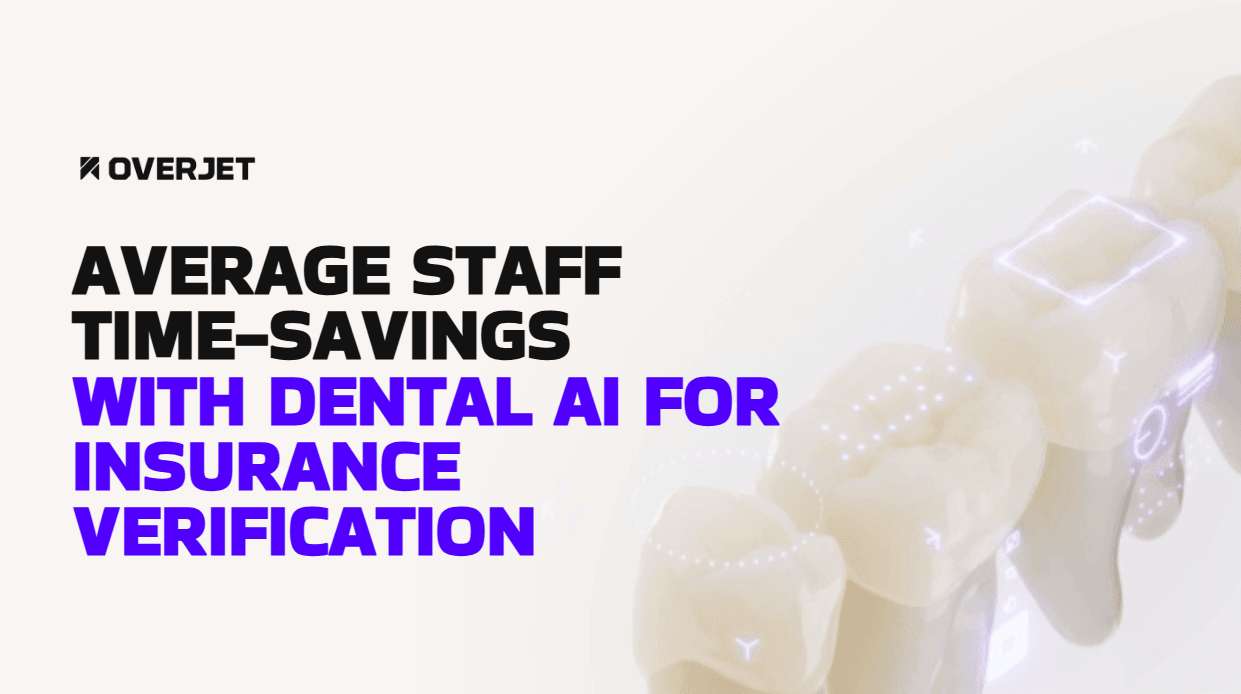Insurance approval delays cost dental practices thousands in lost revenue while patients wait weeks for necessary treatment to begin. When claims lack proper documentation or insurers question clinical necessity, the resulting back-and-forth extends timelines and frustrates everyone involved.
Dental AI transforms this process by automating eligibility verification, generating evidence-based documentation, and predicting denial risks before submission. This article examines how modern AI platforms accelerate approvals, reduce administrative burdens, and help practices deliver timely patient care.
Explore Overjet's Dental AI Software
Why Traditional Dental Approval Workflows Cause Treatment Delays
Dental AI increases insurance approvals and reduces treatment delays by automating administrative tasks, improving claim accuracy, and providing clear, evidence-based documentation for insurers. The technology automates insurance eligibility checks, reduces claim errors by matching correct codes, and analyzes radiographs to automatically generate supporting documentation.
Traditional insurance workflows place significant administrative burdens on dental practices. Staff members spend hours each week manually verifying patient benefits, calling insurance companies, and navigating complex payer portals.
Manual Eligibility Checks Slow Chairside Scheduling
Front office teams often discover coverage issues when patients arrive for appointments. This creates awkward conversations at the chair and forces practices to delay treatment while verifying benefits in real time. Patients become frustrated, schedules get disrupted, and providers can’t deliver care as planned.
Incomplete Documentation Triggers Insurer Follow-Ups
Insurance companies frequently request additional information after initial claim submission. Missing narratives, insufficient radiographic evidence, or unclear clinical notes all prompt follow-up requests. Each request adds days or weeks to the approval timeline, during which patients may experience worsening conditions or lose confidence in their treatment plan.
Radiograph Variability Fuels Reviewer Doubt
Different clinicians interpret the same radiograph differently based on their experience, training, and clinical judgment. This variation creates uncertainty for insurance reviewers who evaluate treatment necessity. When insurers question the clinical justification, they may downgrade procedures, deny claims, or request peer-to-peer reviews.
How AI Interprets Imaging and Clinical Data To Justify Treatment Codes
Dental AI platforms analyze radiographs and clinical documentation using FDA-cleared algorithms trained on millions of images. The systems detect pathology with consistent precision, providing objective measurements and annotations that support treatment recommendations. Overjet’s technology identifies caries, calculus, bone loss, and other conditions, and quantifies their severity according to standardized clinical criteria. Overjet’s FDA-cleared technology analyzes radiographs using algorithms that have received multiple FDA clearances, including the ability to measure bone levels, detect caries (cavities), identify calculus (hardened plaque), and more. (Overjet Earns FDA Clearance to Enhance Dental Images with AI) The platform is trained on millions of clinically annotated radiographs. It provides real-time analysis that helps practices detect conditions like tooth decay and periodontal disease earlier, more accurately, and with greater consistency. (AI for Dental Disease Detection | Overjet Dental AI)
The AI enhances clinical judgment by offering a second set of “eyes” that operates without fatigue or bias. When a provider recommends a restoration, the AI highlights the specific lesion on the radiograph, measures its depth, and generates visual documentation that clearly demonstrates the necessity of treatment.
FDA-Cleared Lesion Detection Enhances Evidence Quality: Overjet’s Unique FDA Clearances and AI Detection Capabilities
FDA clearance means the AI has undergone rigorous validation to ensure its diagnostic accuracy meets medical device standards. When Overjet detects a lesion, Overjet is the first and only dental AI platform that is FDA-cleared to enhance images and is the only dental AI technology that is FDA-cleared to quantify bone level measurements, detect and outline decay (cavities), and detect calculus on radiographs. (Overjet Earns FDA Clearance to Enhance Dental Images with AI) (Overjet Expands Dental AI Detection Capabilities with New FDA Clearance) When Overjet detects conditions, it provides quantifiable data that insurers can verify independently:
Depth measurements: Precise millimeter measurements of decay or bone loss
Anatomical location: Exact tooth and surface identification
Severity classification: Standardized staging based on clinical guidelines
This objective evidence transforms subjective clinical observations into concrete, defensible documentation.
Automated CDT Code Suggestions Align With Findings
Current Dental Terminology (CDT) codes define the procedures dentists perform and bill to insurance. AI systems analyze detected conditions and suggest the most appropriate codes based on clinical guidelines and payer policies. If the AI identifies moderate bone loss, it recommends codes that match that severity level rather than leaving the selection to manual interpretation.
Five Ways Dental AI Accelerates Insurance Approvals And Reduces Denials
Modern dental AI platforms transform insurance workflows through multiple mechanisms that work together to streamline approvals.
1. Real-Time Benefit Verification
AI connects directly to insurance company systems through application programming interfaces (APIs), retrieving current coverage information in seconds. Practices see deductibles, annual maximums, frequency limitations, and coverage percentages without making a phone call or logging into multiple portals. Overjet’s platform automatically verifies as part of the clinical workflow, ensuring teams always have accurate benefit information before presenting treatment plans.
2. Auto-Populated Narratives And Attachments
After analyzing radiographs and clinical notes, AI generates comprehensive narratives that explain the necessity of treatment in language insurers understand. The system automatically attaches annotated images showing detected pathology, eliminating the manual work of writing justifications and selecting supporting documentation.
3. Prior Authorization Routing
Certain procedures require insurer approval before treatment begins. AI identifies authorization requirements based on the patient’s specific plan and automatically initiates the request with all necessary documentation. This proactive approach prevents the common scenario where practices discover authorization requirements after scheduling treatment.
4. Denial Risk Flagging Before Submission
Machine learning models trained on historical claim outcomes predict which submissions are at higher risk of denial. The AI analyzes factors like procedure combinations, frequency limitations, and payer-specific policies to flag potential issues before submission. When the system identifies a concern, it suggests documentation improvements or alternative approaches that increase approval likelihood.
5. Patient-Friendly Visual Reports Improving Consent
AI-generated visual reports show patients exactly what the dentist sees on their radiographs, with pathology highlighted and explained in accessible language. Clear, annotated images help patients understand why treatment is necessary, which increases case acceptance rates and reducing delays caused by patient hesitation. Overjet shows a 25% increase in care acceptance, with providers using Overjet’s AI for patient education and treatment presentation seeing an average 27% increase in case acceptance. (Oryx Integrates Overjet’s Dental AI into Dental Practice Management System - Oryx Dental Software) Clear, annotated images help patients understand why treatment is necessary, increasing case acceptance rates and reducing delays caused by patient hesitation.
Real-Time Eligibility And Prior Authorization Powered By AI
Insurance benefits change frequently. Employers switch carriers, patients lose coverage, or annual maximums reset. Traditional verification methods capture a snapshot in time, but that information may be outdated by the appointment date.
Direct Connections To Payer APIs
Application programming interfaces allow Overjet and similar platforms to query insurance databases directly, retrieving the most current benefit information available. Connections eliminate the telephone game of calling insurance companies and transcribing information that representatives read from their screens. Instead, practices receive structured data that integrates directly into treatment planning and claim submission workflows.
Continuous Coverage Monitoring Before Treatment Day
Rather than verifying benefits once during scheduling, AI systems check coverage status repeatedly as the appointment approaches. If a patient’s insurance terminates or benefits change, the practice receives automatic notification with time to address the issue before the patient arrives.
Predictive Denial Scoring And Automated Narrative Generation
Insurance companies deny or downgrade claims for dozens of reasons. Some relate to clinical justification, others to administrative details, and many stem from payer-specific policies that vary widely across the industry.
Machine Learning Models Trained On Historical EOBs
Explanation of Benefits (EOB) documents detail how insurers adjudicate claims, including the reasons for any denials or reductions in payment. AI platforms ingest EOBs to train predictive models that recognize denial patterns. When Overjet analyzes a new claim before submission, it compares the case against historical knowledge to estimate approval probability and identify potential red flags.
Suggested Edits To Reduce Adjudication Questions
When the AI identifies a potential issue, it suggests improvements before submission:
Capture an additional radiographic angle for marginal image quality
Add specific measurements to narratives lacking clinical details
Include a periodontal chart demonstrating disease progression
Preemptive edits address the questions reviewers would likely ask, reducing the back-and-forth that extends approval timelines.
Implementation Guide: Integrating AI Into Your PMS And Imaging Stack
Adopting dental AI requires thoughtful planning to ensure smooth integration with existing systems and workflows. The goal is to enhance efficiency without disrupting daily operations or overwhelming staff with new technology.
1. Assess Current Workflows
Start by mapping existing insurance verification and claim submission processes. Document how long each step takes, where bottlenecks occur, and which tasks consume the most staff time. This baseline assessment helps measure improvement after AI implementation and identifies the highest-priority areas for automation.
2. Map Data Integrations
AI platforms need access to practice management software (PMS) and imaging systems to function effectively. Work with technology vendors to establish secure data connections that allow the AI to retrieve patient demographics, treatment plans, radiographs, and clinical notes. Overjet integrates with leading PMS and imaging platforms through standard healthcare data exchange protocols, minimizing technical complexity for practices.
3. Train Clinical And Front Office Teams
Even intuitive AI tools require training to maximize their value. Clinical teams learn how AI supports diagnosis and treatment planning, while front-office staff learn how automated verification and claim submission work. Effective training emphasizes how AI reduces workload rather than adding complexity.
4. Monitor Compliance And Security
Healthcare AI platforms handle protected health information (PHI), which means they fall under HIPAA regulations and cybersecurity requirements. Verify that your chosen platform maintains appropriate security certifications, encrypts data in transit and at rest, and provides audit logs for compliance documentation.
Measuring Success: Key KPIs After Deploying Dental AI
Quantifying AI’s impact requires tracking specific metrics that reflect both operational efficiency and financial performance.
Days To Approval
Measure the time between claim submission and insurer approval decision. After deploying Overjet’s automated documentation and submission tools, practices often see timelines reduced by significant margins, with some claims approved within 24-48 hours.“We’ve seen our average reimbursement period drop dramatically” (Overjet - Dental AI Platform for Providers & Payers) according to customer testimonials.
Denial Percentage
Track what percentage of submitted claims receive denials or downgrades requiring appeals. Practices using AI-powered claim review typically reduce denial rates to single digits by catching issues before submission and providing stronger clinical documentation.
Revenue Per Scheduled Hour
This metric captures overall practice efficiency by dividing collections by scheduled clinical hours. When AI accelerates approvals and reduces denials, practices collect payment faster and spend less time on administrative rework.
Ready to reduce treatment delays and accelerate insurance approvals?
Overjet delivers a 90% reduction in administrative work for Utilization Review.
The Future Of Frictionless Dental Payments Starts With AI
The dental industry is moving toward real-time adjudication, where claims are approved instantly at the point of service. This vision requires the kind of automated documentation, eligibility verification, and predictive analytics that AI platforms provide today. As payers adopt more sophisticated technology, practices that use advanced AI will be positioned to benefit from faster payment cycles and reduced administrative friction.
Overjet is leading this transformation by continuously expanding its AI capabilities and payer integrations. The platform’s roadmap includes predictive treatment planning that suggests optimal sequencing based on insurance coverage. These automated appeals generate supporting documentation when claims are denied, and enhanced patient communication tools that improve case acceptance through better education.
Ready to See Overjet's Dental AI in Action?
Frequently Asked Questions (FAQs)
How does dental AI keep patient health information secure during payer exchanges?
AI platforms like Overjet use encrypted connections and HIPAA-compliant protocols when transmitting data to insurance systems. All patient information is encrypted both in transit and at rest, with access controls and audit logging that track every interaction with protected health data.
Can dental AI handle out-of-network benefit checks?
Modern AI systems verify benefits for both in-network and out-of-network providers through direct payer connections. The platform retrieves applicable deductibles, coinsurance percentages, and annual maximums regardless of network status, though out-of-network benefits may have different coverage levels.
How long does it take to roll out dental AI in a multi-site practice?
Implementation typically takes 4-8 weeks, depending on existing software integrations and staff training requirements. Larger organizations with multiple practice management systems or custom workflows may require additional time for complete deployment. However, many practices begin seeing benefits within the first few weeks as initial integrations go live.









